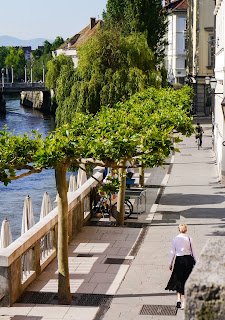Northwest
Ruminations has been silent not for lack of rumination but to edit photos and
produce our latest trip book, The Balkans: Lands of Honey & Blood. (In addition to four-days, eight hours a day, learning from a Hawaiian master to carve stone
pendants and weave Polynesian-style cords and lashings for
them; plus fishing far off the web in northern British Columbia for a week;
plus working as Pratt's board president on our retreat, reflections and re-direction. To boot, I am drafting this en-route to and from Piedmont for grandson Peter Waller’s wonderful wedding to Mary Garner, a perfect Roo to Peter’s Eeyore. The Dr.s Mary and Peter are newly minted PhDs from Cal Berkeley.)
But
about the Balkans: bal in Turkish means honey; kans, blood: an apt metaphor for
these lands of the South Slavs where West has conflicted with East for 1,500
years. These verdant, beautiful lands. These fraught and violent lands. The
first European war of the bloody 20thC took place here; the last European war
of the 20thC took place here along with medieval massacres and cruelties. The first
European war of the 21stC, God forbid? It could likely start here.
These
handsome, lovely people, so hospitable and gracious to us — each of their three
religions teach to welcome the stranger — but they so distrust and detest their neighbors. Croat, Montenegrin, Albanian, Bosniak, Kosovar, Serb, Slovene, Macedonian —
one's ethno-religious background labels you no matter what passport you carry, no
matter how secular or religious you are. After the “Yugoslav Civil War” as
Serbs call it, “The Homeland Wars” to Croats and Bosniaks, these countries now
have self-segregated, becoming more and more homogeneous and rigidly jingoistic.
One Dalmatian Croat living close to “our enemy”, i.e., Montenegro, growled in
explanation to me “Today, neighbor; never friend.” I asked a young, educated,
secular Croat “is there a Balkan Desmond Tutu; what religious leaders are working on
reconciliation?” “None,” he answered, “they are all preaching
superiority and separation.”
Holbrook’s
West-imposed Dayton accords ended the fighting but at a price of establishing
an unstable structure of shared power that emasculates governance and totally
blocks economic re-development. Every former Yugoslav country has lost population
since 1999 — a debilitating brain drain. Bosnia is especially ungovernable,
with everyone hankering back to days of Tito. A Sarajevo actress told us she is longing for “the right strong
man” to come along and sweep all this away. Milorad Dodik,
leader of the federated Republika Srpska, a Dayton-creation, last month announced
formation of an independent Srpska militia and his desire (with Putin egging
him on) to secede from Bosnia and be annexed by Serbia. Last year, Oliver Ivanovo,
Deputy State Minister of Kosovo, was killed in a drive-by assassination, just
another in a long string — one might say “as Balkan as assassination.” The
Serbian prime minister last month charged Kosovo and Albania with plotting to
unite.
Here in these former Yugoslavian countries, for all the world to see, is identity politics taken to its
logical/illogical extreme with a strong undertow of violence mixed in. Yearning, vulnerable, anxious people surrounded by rising
retro-autocrats, populist nationalists like Orban of Hungary, Salvini of Italy,
Hofer of Austria, Erdogan of Turkey., LePen of France: the Balkans are kindling
awaiting a match.
This
OAT* trip revealed to me how little I knew of this amazing, confounding
history. (Churchill quipped “the Balkans produce more history than they can
consume.”) Also, I have learned to revere Rebecca West; her Black Lamb, Grey Falcon (1940), the most marvelous travelogue/history/incisive commentary I have ever read, all
1200 pages of it.
Do
not let me dissuade you. Go explore the Balkans. Enjoy sun in the Dalmatian
islands. Wonder at Roman emperor Diocletian’s retirement Palace in Split, at
the mountains of Montenegro, at the Ottoman bridge of Mostar, at the caves of
Postojna and more — and learn. Learn how little we know of this 1500 year conflict
zone between east and west and how it colors our times. Learn what lack of
diversity can yield in paranoiac chauvinism. Learn what ancient injury can do
to scar national psyche if not healed with vision and leadership and education.
And learn to be a stranger on the receiving end of warm, eager and welcoming
hospitality.
 |
| We on the upper wall around the old town of Dubrovnik, Croatia |
 |
| Motovun, in the Istrian region of Croatia |
 |
| Hunting truffles with an Istrian hunter and her trained sniffer-dog |
 |
| Karanac (kah-RAHN-ass), Croatia: making new cheese for tomorrow's breakfast |
 |
| In the Gulf of Kotor in Montenegro |
 |
| Lake Bled, Slovenia |
 |
| Early morning along the esplanade in Ljubljana, Slovenia |
 |
| Mostar, Bosnia and Herzegovina: the original 16thC Ottoman bridge destroyed by Croat insurgents in the war, 1993, and re-built in 2003-'04 |
 |
| One of the many caverns in Postonja Caves. (Note the walkway for scale.) |
 |
| A "Sarajevo Rose": several hundred mortar shell holes where at least three persons were killed during the three-year siege are memorialized with red resin fillings. |
 |
| Sarajevo, Bosnia and Herzegovina: a display in the Srebrenica Exhibit of mass graves created by Serb and Croat militias and the Yugoslav army during the Bosnian War, 1992- '95 |
 |
| Split: an early-morning fashion shoot in one of the plazas of Diocletian's retirement palace. |
 |
| Split, Croatia: Mestrovic's statue of Bishop Gregory of Nin, who performed the mass in Serbo-Croation and was banished for his transgression -- 500 years before Luther! |
 |
| Zagreb, Croatia: Cardinal Stepanic. Saint or War Criminal? |
 |
| The Austro-Hungarian skyline of old Zagreb |
 |
| And that BC fishing trip? An insufferably satisfied Roger W, a fishing pal who consistently out-fishes me, with a nice kamloops rainbow. |


No comments:
Post a Comment